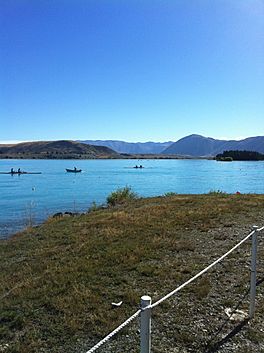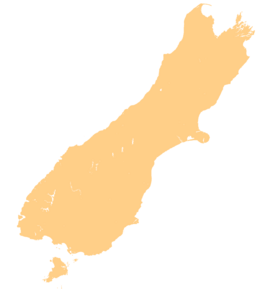Lake Ruataniwha facts for kids
Quick facts for kids Lake Ruataniwha |
|
|---|---|

Rowing on Lake Ruataniwha
|
|
| Location | South Island |
| Coordinates | 44°16′52″S 170°04′16″E / 44.281°S 170.071°E |
| Type | Artificial lake |
| Primary inflows | Ōhau River |
| Basin countries | New Zealand |
Lake Ruataniwha is a special lake in the South Island of New Zealand. It's not a natural lake; it was made by people between 1977 and 1981. This was done as part of a big project to create hydroelectricity, which is power made from moving water. The lake is near the town of Twizel.
The lake got its name from a large sheep station called Ruataniwha Station. Part of this land was bought to build the town of Twizel. Ruataniwha was also the name of a Māori chief. He sadly drowned a long time ago when his canoe, the Arai-te-uru, sank near Moeraki.
About Lake Ruataniwha
Lake Ruataniwha is about 4.5 kilometres (2.8 miles) long. It covers an area of 3.4 square kilometres (1.3 square miles).
The lake was created by the New Zealand Ministry of Works. They built a dam across a gorge where the Ōhau River used to flow. This dam, called the Ruataniwha Dam, now has State Highway 8 running across its top. This road connects Twizel and Omarama.
Water flows into Lake Ruataniwha from the Ohau A power station. Sometimes, extra water from Lake Ōhau also flows into it. This happens down the riverbed of the Ohau River, which is usually dry.
Water leaves Lake Ruataniwha through a natural gap in the dam. It then flows into a canal that leads to the Ohau B power station. Close by is a smaller lake called Wairepo Arm. Another small pond, Kellands Pond, is connected to Wairepo Arm.
There's also a special spillway built into the dam. It has three gates that can release a lot of water very quickly. This water flows into the Ohau River's dry bed. The lake acts like a "surge reservoir" for the power system. This means it can hold extra water if there's too much coming in, or if the power stations can't handle it all.
How the Lake Was Built
Building Lake Ruataniwha was a big job! First, the Ohau River had to be moved. Workers dug a new channel through some rocky land. They built three special gates there using a huge amount of concrete. In August 1980, the river was sent through this new channel.
Later that year, the river was moved again, away from its original path. This allowed workers to build the main dam. The main dam is 240 metres (787 feet) long. There's also a smaller dam next to it that is 480 metres (1,575 feet) long. These dams are made of earth and gravel.
Once the dam was finished, the gates were closed. This started to fill the area behind the dam with water in March 1982. The lake was officially opened on Saturday, April 24, 1982. It was a big event, with 7,000 people watching. A rowing competition was held, with 188 teams from 80 different clubs!
Fun Activities at the Lake
Lake Ruataniwha is not just for making electricity; it's also a fantastic place for fun! The Ministry of Works helped turn it into a major spot for recreation. They planted many trees and built a holiday park right by the lake.
One of the most popular activities at Lake Ruataniwha is rowing. It's one of New Zealand's main places for this sport. This wasn't originally part of the plan for the hydroelectric project. However, Max Smith, who was the Project Engineer for the area, wanted to create something special for the community.
He made sure that facilities for rowing were built before the lake was even filled. This included surveying the rowing course and putting down anchors for lane markers. He also worked with the Rowing Association to get a building for controlling regattas (rowing races).
The lake's facilities are impressive. They can hold 600 rowing boats and welcome 2,000 competitors at once. The rowing course has eight lanes. The regatta control building has rooms for first aid, administration, and storage. Upstairs, there are special areas for judges, timekeepers, and commentators.
Lake Ruataniwha usually hosts about five big rowing events each year. The New Zealand national rowing championships are held there every two years. In between, the national secondary school rowing championships take place, where students compete for the famous Maadi Cup.
Besides rowing, the lake is also a great place for other water sports. You can go swimming, yachting, canoeing, and windsurfing there.



